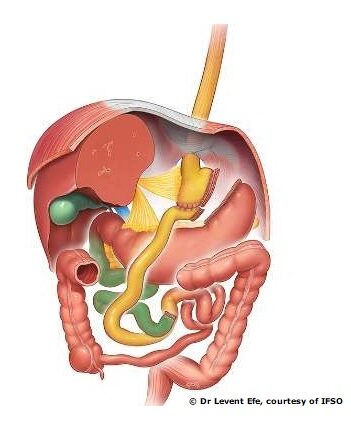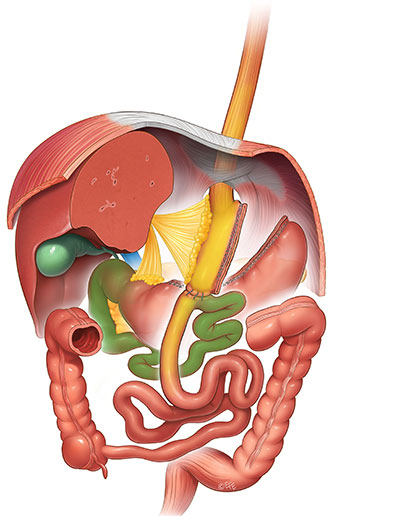Weight loss surgery Darwin
Bariatric surgery is the recommended treatment for severe obesity and has benefits that extend to resolution of other related health problems including diabetes, obstructive sleep apnoea, polycystic ovarian syndrome. There are a number of options and some procedures are more suitable for certain patients.
Dr Kim Bade is passionate about weight loss surgery and is experienced in the most commonly performed bariatric procedures in Australia and worldwide ; sleeve gastrectomy, Roux-en-Y gastric bypass, one anastomosis gastric bypass & gastric band surgery. He has a particular interest and experience in revisional surgery should you have had a previous procedure with a sub-optimal outcome. Kim is a member of the Australian and New Zealand Bariatric Surgical Society (ANZMOSS) and the International Federation for the Surgery of Obesity (IFSO)
Dr Kim Bade consults at Darwin Specialist Surgeons in Darwin Private Hospital. Kim works with a number of other health professionals to optimise your outcome after surgery; your GP, dietician, perioperative physician, psychologist & exercise physiologist.


Weight Loss Options
Deciding on a weight loss procedure?
There are a number of surgical weight loss options for most patients. Many patients have a preference for a particular bariatric procedure. At your appointment we will discuss the benefits and disadvantages of each approach as well as answer any questions or concerns. The options may depend on other factors such as pre-existing surgery or whether you have reflux.
Sleeve Gastrectomy
Gastric sleeve is the most commonly performed bariatric surgery worldwide. Most patients lose approximately 60% of their excess weight It is effective at treating a number of medical problems associated with obesity such as diabetes, high blood pressure, high cholesterol, osteoarthritis, polycystic ovarian syndrome & weight related infertility.
Gastric Bypass
Gastric bypass is the second most commonly performed bariatric procedure worldwide. It offers slightly more weight loss than sleeve gastrectomy, it is better at treating diabetes and is suitable for patients with gastroesophageal reflux.
Roux En Y Gastric Bypass
One Anastomosis Gastric Bypass
Single Anastomosis Duodenal-Iliostomy (SADI)

Gastric Band Surgery and other revisional procedures
Dr Kim Bade has extensive experience and training in re-operative bariatric surgery. You may have had an inadequate result from an original procedure or a complication such as reflux. Dr Bade can provide advice, options and a treatment plan to optimise your outcome.
Removal of gastric band
Band to sleeve
Band to bypass
Revision of gastric bypass
Weight loss surgery Darwin
Sleeve Gastrectomy
Sleeve gastrectomy induces weight loss by restricting the stomach volume and making patients feel full sooner. The removed area of stomach is also responsible for producing a hormone that contributes to the sensation of hunger and thereby causes decreased appetite.
Sleeve gastrectomy is the most commonly performed weight loss procedure in Australia and worldwide. This is because it produces rapid sustainable weight loss (on average 60-70% excess weight loss) associated with a good safety profile. The operation is undertaken through 5 small keyhole incisions and takes approximately 1 hour. The procedure involves removing the outer aspect of the stomach such that the stomach volume is reduced by 80-85%. Patients generally stay in hospital 2-3 days following surgery.
Benefits of sleeve gastrectomy are it’s favourable safety profile along with significant durable weight loss and improvement in obesity related medical problems. Disadvantages are that it can induce or worsen reflux in some patients and it is not as effective as gastric bypass in achieving resolution of diabetes.
Gastric Sleeve Surgery
How is it done?

The edge of the stomach is stapled using a 36 French bougie guide and the remainder is removed to reduce it’s volume by 80-85% (approximately 80-100mls). This also removes cells in the stomach that secrete hunger hormones resulting in decreased appetite.
Weight loss surgery Darwin
Roux-En-Y Gastric Bypass
Roux-en-y gastric bypass (RNYGB) induces weight loss by restricting the stomach volume and by inducing malabsorption by bypassing some of the small intestine. RNYGB is the second most common weight loss operation worldwide and it’s results are backed up by decades of data on outcomes.
Benefits of RNYGB are significant durable weight loss and improvement in obesity related medical problems, particularly diabetes. In particular RNYGB is a better operation for patients with significant reflux which can be made worse by sleeve gastrectomy.
The operation is undertaken through 5 small keyhole incisions and takes approximately 1.5 – 2 hours. Patients generally stay in hospital 2-3 days following surgery.
Roux-En-Y Gastric Bypass
How is it done?

A small stomach pouch is created which is connected to the small intestine. There is a second intestinal join downstream such that approximately 2 metres of small bowel is bypassed. This results in early satiety and also reduced food absorption.
Weight loss surgery Darwin
One Anastomosis Gastric Bypass
One-anastomosis gastric bypass (OAGB) also known as mini gastric bypass or omega-loop gastric bypass is a bariatric procedure that induces weight loss both by reducing the volume of the stomach inducing early satiety, and also by bypassing a portion of the small bowel such that less absorption takes place. Approximate weight loss results are 65 – 75%. Unlike RNYGB there is only one anastomosis (join) between the stomach and small intestine.
Advantages of OAGB are a favourable safety profile with only one anastomosis, slightly better weight loss compared to sleeve gastrectomy and better resolution of diabetes in patients with this condition.
Disadvantages are less long term data on outcomes (as this is a newer procedure compared to sleeve and roux-en-y gastric bypass), development of bile reflux in some patients and greater nutritional issues compared to sleeve in the longer term
One Anastomosis Gastric Bypass
How is it done?

A small stomach pouch is created which is connected to the small intestine. There is a second intestinal join downstream such that approximately 2 metres of small bowel is bypassed. This results in early satiety and also reduced food absorption.
Weight loss surgery Darwin
Gastric band surgery & revisional procedures
Dr Kim is experienced in revisional bariatric surgery. Whether you have a problem following an initial operation such as the development of reflux after sleeve gastrectomy, a sub-optimal weight loss outcome, or any other issue or concern. Please make an appointment to discuss your options further.

Revisional Bariatric Surgery
Removal of Gastric Band
Band to Sleeve
Band to Bypass
Sleeve to Bypass
Other Revisional Surgey
FAQ
Frequently Asked Questions
How do I make an appointment?
See your GP to get a referral and then call to make an appointment. If you already have a referral to another surgeon that is not a problem – you are able to use that referral with any surgeon you choose including us.
What is the eligibility criteria for weight loss surgery?
The most recent International guidelines and Australian guidelines released in 2021 recommend bariatric surgery if your BMI is greater than 30 with any weight related medical comorbidity, or if BMI is greater than 35 with or without weight related medical problems. This criteria is modified/lowered for some ethnic groups that are at higher risk of weight related medical problems.
When can I return to a normal diet after bariatric surgery?
Following surgery whilst the stomach is healing it is important that patients have a modifiet diet for 6 weeks. This progresses from fluids back to solid food. You should be able to return to a normal diet approximately 6 weeks after the procedure, however portion sizes are much smaller than previous, and will remain so for many months and even years
How long does it take to recover after bariatric surgery??
Typically most stay 2-3 days in hospital and take 2 weeks off work to allow sufficient recovery time following surgery. Driving is generally ok 3 days after discharge.
Is the gastric band reversable?
Because the stomach isn’t stapled or removed the gastric band is reversable. We can discuss removal of gastric band and also conversion to sleeve gastrectomy or gastric bypass.
How much does weight loss surgery cost in Darwin?
Weight loss surgery costs and associated fees are made up of several components:
1. Hospital charges for bed stay
2. Hospital charges for operating theatre session
3. Equipment used in the operating theatre session. This includes the:
- Devices such as staplers and other disposables
- Professional fees charged by the surgeon, anaesthetist and surgeon assistants
Patients with an appropriate level of private health insurance cover will find most hospital and equipment charges will incur a “no gap” fee. The out of pocket expenses for insured patients relate mostly to professional and clinic fees charged by the surgeon, anaesthetist and their assistants.
The out of pocket fees vary depending on your health fund & surgery but are approximately $3000-5000. We will do a quote following your appointment and you will need to call your health fund to confirm you are covered.
If you do not have private cover you can:
1. Take out private cover and wait 12 months to complete the exclusion period,
2. Obtain early access to superannuation from the ATO which allows for early access to cover weight loss surgery (we can discuss this with you and supply the necessary paperwork if required).
Contact Us
To make an appointment please phone or email. You will need a referral from your GP (this referral can be to addressed to any surgeon and can be used to make an appointment with the surgeon of your preference).
Consulting Suites
Ground Floor, Darwin Private Hospital, Rocklands Drive, Tiwi, Darwin, NT 0810
Email Us
DarwinSpecialistSurgeons@outlook.com
Call Us
(08) 89206198
Fax
(08) 89206199